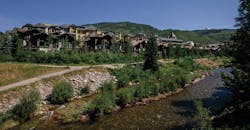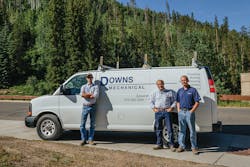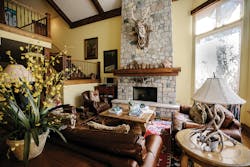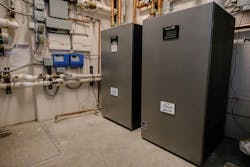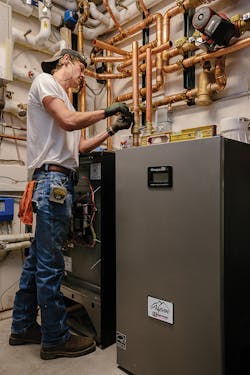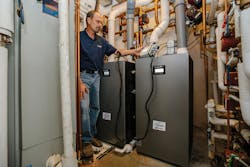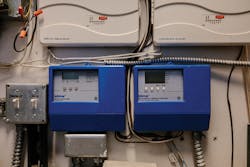Only a few towns in the US really qualify for the moniker “ski town.” Sure, there’s great downhill skiing in hundreds of towns across America, but only a handful exist for the sole purpose of alpine skiing. Vail, Jackson Hole, Aspen, Telluride, Big Sky, to name some of the greats, have strong economies that rely almost entirely on the revenue generated as a result of winter mountain sports.
In these places, Swiss-style chalets, ski-up shops and all variety of resorts blend together at the base the of the slopes, forming a ribbon of super-high dollar real estate owned and occupied by the elite.
For mechanical contractors, particularly those that specialize in hydronic heat, resort town economies are tough to beat. Ski towns crave oxygen barrier PEX almost as much as a fresh powder snow. Sidewalks, steps and landings throughout the resorts are often equipped with snowmelt systems, and custom homes and high-end condos that don’t have in-floor heat are scarce as hen’s teeth.
Bill Downs, who founded Downs Mechanical in 1982, has a pretty small territory, thanks entirely to the company’s reputation in nearby Vail, CO.
“We drive 15 miles east to Vail, and 15 miles west, to Eagle,” he explained. “We have over 300 return customers in this valley, from residential accounts to resorts, hospitals and schools. Service, replacement and preventative maintenance is our forte, and we find ourselves working for big property management firms as often as not.”
Last year, Downs was approached by the general contractor that built a row of high-end condos next to the Ritz-Carlton and right on Gore Creek. Downs has done work for the builder since 2008, and this time, the discussion revolved around the need to replace the boilers in six condominiums in downtown Vail.
The original boilers in the 5,000 square-foot condos were beginning to fail. Each residence is each worth about $10M, so it’s no surprise that each unit was equipped with two large condensing boilers.
Two boilers, four water temperatures
“When these homes were built, high-efficiency boilers with aluminum heat exchangers were installed,” said Downs. “These degraded faster than expected, and there have been enough failures across the whole development to warrant replacement of all the units. There was no doubt that the retrofits would include the use of a stainless steel boiler.”
The property maintenance group wanted to have full boiler redundancy as part of the retrofit, and the project was scheduled to begin after the 2018-2019 ski season. During the summer of 2019, Downs was tasked with removing and replacing the old boilers.
The three-story condos include private, underground parking, all connected by a gated, subterranean drive. The boilers are installed in a small mechanical rooms connected to the garages.
Each home has two stages of heat: in-floor radiant and fan coil units. The first floor patios and the second-story decks are equipped with snow melt systems, totaling 600 square-feet. The need to fill huge soaking tubs and provide hot water to multi-head showers requires a great deal of domestic hot water, so 120-gallon instantaneous indirect-fired water heaters are also installed in the mechanical rooms.
While ski-season was winding down this past spring, Bill’s son Mike began working with Ferguson and McCoy Sales to design new boiler systems based on the use of U.S. Boiler Company’s Aspen Light Commercial condensing boiler.
“One big difference between the old and new systems is the way we’re staging boilers,” said Mike. “Previously, one of the boilers was dedicated to supplying domestic hot water, while the other unit provided space heat and snowmelt. The DHW boiler ran year-round maintaining setpoint whether or not the condo is occupied. Meanwhile, the second boiler ran only during heating season. So there was a big difference in wear and tear.”
“Our relationship with Ferguson is long-standing, and we’ve worked specifically with Matt Patchett, Ferguson Hydronics, for about four years” said Downs. “He helps with blueprints, heat loss calculations and piping diagrams.”
“When we took this project to them, there were several boilers to choose from,” continued Downs. “We’ve used the smaller, wall-hung Aspen boilers for a year, and we like them because of their easy programming and the ability to pipe the units from the top or bottom. What really won us over to the Aspen Light Commercial on this job was the piping and venting configurations, and the fact that they could be floor-mounted.”
“The boilers fit the mechanical rooms, physically,” said Patchett. “I also liked the fact that each unit provides a 10:1 turndown ratio, so by pairing them up, each system provides 20:1 modulation. That’s a big advantage in volatile mountain weather and with snow events that can quickly raise the load on the system via the snowmelt loops.”
Overcoming challenges
Because of the space constraints in each of the 15 mechanical rooms, Downs needed a boiler that could be vented from the top of the unit. But simply having a top-vent unit didn’t make the venting portion of the job easy. McLaughlin helped Downs create a venting system that exceeded both code and manufacturer requirements.
The condos are constructed in a row, and the mechanical rooms are in the basement, so the venting needed to run across the home to be terminated. The entire length of the flu was within confined space.
“We couldn’t use PVC in a confined space,” said Mike. “And polypropylene grade requirements were too high for some of the drop ceilings we needed to pass through. That left us with schedule 80 CPVC, which has a ¼” per foot grade requirement. It’s heavy and expensive, but we can all sleep at night!”
Downs Mechanical also found that the original mixing controls weren’t working properly in many of the condos. To compound the issue, there was no access to the mixing valves.
In order to replace the mixing valves, Downs technicians were forced to put access panels within the living space. Water from the boilers is supplied at roughly 160°F to 180°F, and tempered down depending on whether stage 1 heat, stage 2 heat, or snowmelt calls.
In addition to designing the venting system, McLaughlin was onsite sporadically throughout the summer to do combustion analysis as units were fired.
“Because of the way the gas venturi and combustion system in the Aspen is designed, these boilers require far less derate at altitude than most others,” said McLaughlin. “Here in Vail, at 8,200 feet above sea level, I need to derate these boilers to a degree, but not nearly as much as I would otherwise. The Aspen is becoming pretty common in Colorado as a result.”
The project wrapped up in late 2019, just in time for Downs to focus on no-heat calls, and right before all the alpinists reoccupy Vail.
